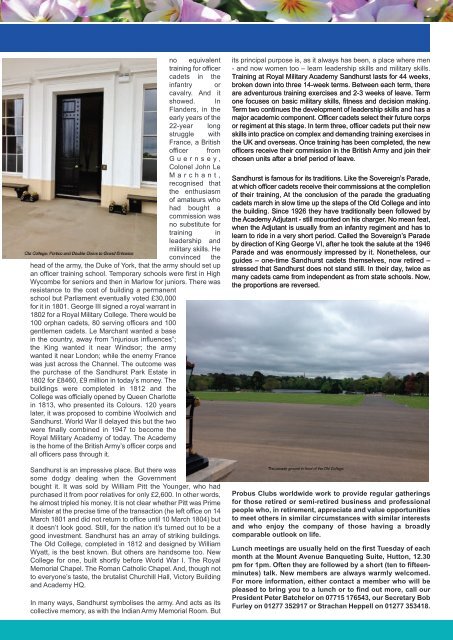Journals June 2018
Create successful ePaper yourself
Turn your PDF publications into a flip-book with our unique Google optimized e-Paper software.
no equivalent<br />
training for officer<br />
cadets in the<br />
infantry or<br />
cavalry. And it<br />
showed. In<br />
Flanders, in the<br />
early years of the<br />
22-year long<br />
struggle with<br />
France, a British<br />
officer from<br />
G u e r n s e y ,<br />
Colonel John Le<br />
M a r c h a n t ,<br />
recognised that<br />
the enthusiasm<br />
of amateurs who<br />
had bought a<br />
commission was<br />
no substitute for<br />
training in<br />
leadership and<br />
military skills. He<br />
convinced the<br />
head of the army, the Duke of York, that the army should set up<br />
an officer training school. Temporary schools were first in High<br />
Wycombe for seniors and then in Marlow for juniors. There was<br />
resistance to the cost of building a permanent<br />
school but Parliament eventually voted £30,000<br />
for it in 1801. George III signed a royal warrant in<br />
1802 for a Royal Military College. There would be<br />
100 orphan cadets, 80 serving officers and 100<br />
gentlemen cadets. Le Marchant wanted a base<br />
in the country, away from “injurious influences”;<br />
the King wanted it near Windsor; the army<br />
wanted it near London; while the enemy France<br />
was just across the Channel. The outcome was<br />
the purchase of the Sandhurst Park Estate in<br />
1802 for £8460, £9 million in today’s money. The<br />
buildings were completed in 1812 and the<br />
College was officially opened by Queen Charlotte<br />
in 1813, who presented its Colours. 120 years<br />
later, it was proposed to combine Woolwich and<br />
Sandhurst. World War II delayed this but the two<br />
were finally combined in 1947 to become the<br />
Royal Military Academy of today. The Academy<br />
is the home of the British Army’s officer corps and<br />
all officers pass through it.<br />
Sandhurst is an impressive place. But there was<br />
some dodgy dealing when the Government<br />
bought it. It was sold by William Pitt the Younger, who had<br />
purchased it from poor relatives for only £2,600. In other words,<br />
he almost tripled his money. It is not clear whether Pitt was Prime<br />
Minister at the precise time of the transaction (he left office on 14<br />
March 1801 and did not return to office until 10 March 1804) but<br />
it doesn’t look good. Still, for the nation it’s turned out to be a<br />
good investment. Sandhurst has an array of striking buildings.<br />
The Old College, completed in 1812 and designed by William<br />
Wyatt, is the best known. But others are handsome too. New<br />
College for one, built shortly before World War I. The Royal<br />
Memorial Chapel. The Roman Catholic Chapel. And, though not<br />
to everyone’s taste, the brutalist Churchill Hall, Victory Building<br />
and Academy HQ.<br />
In many ways, Sandhurst symbolises the army. And acts as its<br />
collective memory, as with the Indian Army Memorial Room. But<br />
e Journal<br />
its principal purpose is, as it always has been, a place where men<br />
- and now women too – learn leadership skills and military skills.<br />
Training at Royal Military Academy Sandhurst lasts for 44 weeks,<br />
broken down into three 14-week terms. Between each term, there<br />
are adventurous training exercises and 2-3 weeks of leave. Term<br />
one focuses on basic military skills, fitness and decision making.<br />
Term two continues the development of leadership skills and has a<br />
major academic component. Officer cadets select their future corps<br />
or regiment at this stage. In term three, officer cadets put their new<br />
skills into practice on complex and demanding training exercises in<br />
the UK and overseas. Once training has been completed, the new<br />
officers receive their commission in the British Army and join their<br />
chosen units after a brief period of leave.<br />
Sandhurst is famous for its traditions. Like the Sovereign’s Parade,<br />
at which officer cadets receive their commissions at the completion<br />
of their training, At the conclusion of the parade the graduating<br />
cadets march in slow time up the steps of the Old College and into<br />
the building. Since 1926 they have traditionally been followed by<br />
the Academy Adjutant - still mounted on his charger. No mean feat,<br />
when the Adjutant is usually from an infantry regiment and has to<br />
learn to ride in a very short period. Called the Sovereign’s Parade<br />
by direction of King George VI, after he took the salute at the 1946<br />
Parade and was enormously impressed by it. Nonetheless, our<br />
guides – one-time Sandhurst cadets themselves, now retired –<br />
stressed that Sandhurst does not stand still. In their day, twice as<br />
many cadets came from independent as from state schools. Now,<br />
the proportions are reversed.<br />
Probus Clubs worldwide work to provide regular gatherings<br />
for those retired or semi-retired business and professional<br />
people who, in retirement, appreciate and value opportunities<br />
to meet others in similar circumstances with similar interests<br />
and who enjoy the company of those having a broadly<br />
comparable outlook on life.<br />
Lunch meetings are usually held on the first Tuesday of each<br />
month at the Mount Avenue Banqueting Suite, Hutton, 12.30<br />
pm for 1pm. Often they are followed by a short (ten to fifteenminutes)<br />
talk. New members are always warmly welcomed.<br />
For more information, either contact a member who will be<br />
pleased to bring you to a lunch or to find out more, call our<br />
President Peter Batchelor on 07715 176543, our Secretary Bob<br />
Furley on 01277 352917 or Strachan Heppell on 01277 353418.<br />
13


















